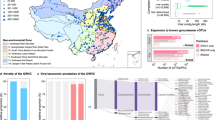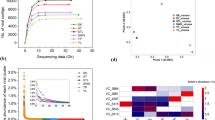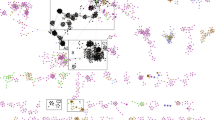Abstract
The objectives of this study were to determine if viruses exist in deep granitic groundwater and to analyse their abundance and morphological diversity. Fluorescent microscopy counts on 10 groundwater samples ranging from 69 to 450 m depth were in the range of 104–106 TNC ml−1 (TNC, total number of prokaryotic cells) and 105–107 VLP ml−1 (VLP, virus-like particles). A good positive correlation of VLP with TNC (r=0.91, P=0.0003) was found with an average VLP/TNC ratio of 12. Transmission electron microscopy revealed four distinct bacteriophage groups (polyhedral, tailed, filamentous and pleomorphic) with at least seven phage families of which some are known to be lytic. Our results suggest the presence of viruses in deep granitic groundwater up to 450 m depth. If they are active and lytic, they will constitute an important group of predators that might control the numbers of microorganisms in the analysed groundwater.
Similar content being viewed by others
Log in or create a free account to read this content
Gain free access to this article, as well as selected content from this journal and more on nature.com
or
References
Amend JP, Teske A . (2005). Expanding frontiers in deep subsurface microbiology. Palaeogeogr Palaeoclimatol Palaeoecol 219: 131–155.
Banwart S, Gustafsson E, Laaksoharju M, Nilson AC, Tullborg EL, Wallin B . (1994). Large-scale intrusion of shallow water into a granite aquifer. Water Resour Res 30: 1747–1763.
Banwart S, Tullborg EL, Pedersen K, Gustafsson E, Laaksoharju M, Nilson AC et al. (1996). Organic carbon oxidation induced by large-scale shallow water intrusion into a vertical fracture zone at the Äspö Hard Rock Laboratory (Sweden). J Contam Hydrol 21: 115–125.
Chen F, Lu JR, Binder BJ, Liu YC, Hodson RE . (2001). Application of digital image analysis and flow cytometry to enumerate marine viruses stained with SYBR gold. Appl Environ Microbiol 67: 539–545.
Corinaldesi C, Crevatin E, Del Negro P, Marini M, Russo A, Fonda-Umani S et al. (2003). Large-scale spatial distribution of virioplankton in the Adriatic Sea: testing the trophic state control hypothesis. Appl Environ Microbiol 69: 2664–2673.
Danovaro R, Manini E, Dell'Anno A . (2002). Higher abundance of bacteria than of viruses in deep Mediterranean sediments. Appl Environ Microbiol 68: 1468–1472.
Eydal HSC, Pedersen K . (2007). Use of an ATP assay to determine viable microbial biomass in Fennoscandian Shield groundwater from depths of 3−1000 m. J Microbiol Methods 70: 363–373.
Fredrickson JK, Balkwill DL . (2006). Geomicrobiological processes and biodiversity in the deep terrestrial subsurface. Geomicrobiol J 23: 345–356.
Laaksoharju M, Shårman C, Shårman E . (1999a). Multivariate mixing and mass balance (M3) calculations, a new tool for decoding hydrogeochemical information. Appl Geochem 14: 861–871.
Laaksoharju M, Tullborg EL, Wikberg P, Wallin B, Smellie J . (1999b). Hydrogeochemical conditions and evolution at Äspö HRL, Sweden. Appl Geochem 147: 835–859.
Lin LH, Wang PL, Rumble D, Lippmann-Pipke J, Boice E, Pratt LM et al. (2006). Long-term sustainability of a high-energy low-diversity crustal biome. Science 314: 479–482.
Marshall KC . (1976). Interfaces in Microbial Ecology. Harvard University Press: Cambridge pp 1–156.
Middelboe M, Glud RN, Finster K . (2003). Distribution of viruses and bacteria in relation to diagenetic activity in an estuarine sediment. Limno Oceanogr 48: 1447–1456.
Noble RT, Fuhrman JA . (1998). Use of SYBR Green I for rapid epifluorescence counts of marine viruses and bacteria. Aquat Microb Ecol 14: 113–118.
Pedersen K . (2001). Diversity and activity of microorganisms in deep igneous rock aquifers of the Fennoscandian Shield. In: Fredrickson JK, Fletcher M (eds). Subsurface Microbiology and Biogeochemistry. Applied and Ecological Microbiology. Wiley-Liss Inc: New York, pp 97–139.
Pedersen K . (2002). Microbial processes in the disposal of high level radioactive waste 500 m underground in Fennoscandian shield rocks. In: Keith-Roach MJ, Livens FR (eds). Interactions of Microorganisms with Radionuclides. Radioactivity in the environment 2. Elsevier: Amsterdam, pp 279–311.
Pedersen K, Ekendahl S . (1992). Incorporation of CO2 and introduced organic compounds by bacterial populations in groundwater from the deep crystalline bedrock of the Stripa mine. J Gen Microbiol 138: 369–376.
Prangishvili D, Forterre P, Garrett RA . (2006a). Viruses of the Archaea: a unifying view. Nature 4: 837–848.
Prangishvili D, Garret RA, Koonin EV . (2006b). Evolutionary genomics of archaeal viruses: unique viral genomes in the third domain of life. Virus Res 117: 52–67.
Wiggins BA, Alexander M . (1985). Minimum bacterial density for bacteriophage replication: implications for significance of bacteriophages in natural ecosystems. Appl Environ Microbiol 49: 19–23.
Acknowledgements
This research was made possible by generous support from the Swedish Foundation for International Cooperation in Research Higher Education (STINT), the Swedish Nuclear Fuel and Waste Management Co. (SKB) and the Swedish Science Research Council (VR). We thank the personnel at the Äspö Hard Rock Laboratory for their general support during our sampling and analysis fieldwork. Sara Eriksson and Lotta Hallbeck are acknowledged for valuable comments on the paper.
Author information
Authors and Affiliations
Corresponding author
Rights and permissions
About this article
Cite this article
Kyle, J., Eydal, H., Ferris, F. et al. Viruses in granitic groundwater from 69 to 450 m depth of the Äspö hard rock laboratory, Sweden. ISME J 2, 571–574 (2008). https://doi.org/10.1038/ismej.2008.18
Received:
Revised:
Accepted:
Published:
Issue date:
DOI: https://doi.org/10.1038/ismej.2008.18
Keywords
This article is cited by
-
Scientific and technological progress in the microbial exploration of the hadal zone
Marine Life Science & Technology (2022)
-
Energy efficiency and biological interactions define the core microbiome of deep oligotrophic groundwater
Nature Communications (2021)
-
The Fennoscandian Shield deep terrestrial virosphere suggests slow motion ‘boom and burst’ cycles
Communications Biology (2021)
-
The biomass and biodiversity of the continental subsurface
Nature Geoscience (2018)
-
Potential for hydrogen-oxidizing chemolithoautotrophic and diazotrophic populations to initiate biofilm formation in oligotrophic, deep terrestrial subsurface waters
Microbiome (2017)



